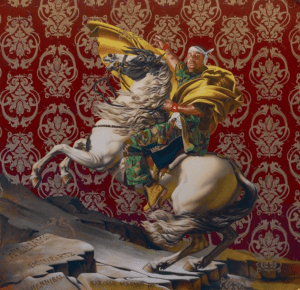Kehinde Wiley, an American artist based in New York, uses his art to celebrate his culture, as well as other aspects of his identity, such as his race, gender, and sexuality. His artwork replicates famous, old paintings of portraits, by taking the subjects of these paintings and replacing them with models that share parts of his identity.
An example is his painting “Napoleon Leading His Army Over The Alps” (above, 1). In this painting, we see a replica of the horse portrayed in Jacques-Louis David’s “Napoleon Crossing the Alps” from 1803 (above, 2). Both the ground and the horse are the same in each painting. The models’ postures in both are the same as well as the cape flying around them.
The most striking difference in these images are the models. David’s painting portrays Napoleon, on a horse, in what seems to be a battle/war outfit from his time period. Wiley’s model also wears an army, camouflage outfit. All of his works have the element of modern clothing as opposed to the traditional clothing in the original, reference piece. While it may seem like an inappropriate outfit to wear on a horse, it shows to contrast between the two paintings’ time periods. The model’s race plays a huge part in the message of this piece. As a black man, Kehinde Wiley wanted to give the black community an opportunity to see themselves in traditional paintings.
In the past, most traditional famous paintings that were showcased in galleries were of white males, as symbols for wealth and honour. Wiley challenged that trend and chose models that relate to him and gave his community a chance to be portrayed as well. It is his way to show his audience that black people, too, can be the same, and do the same things as previous powerful and wealthy white people could.

